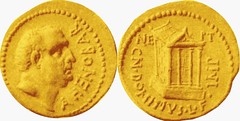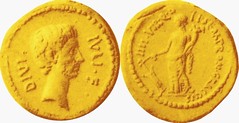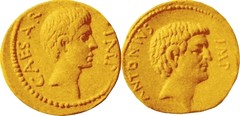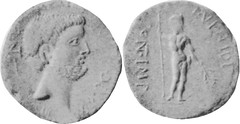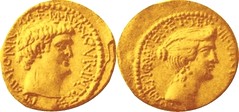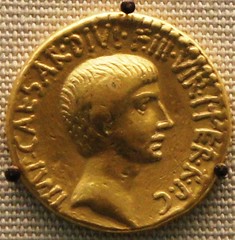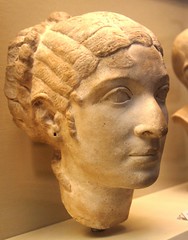Part 19 RRC 516 to RRC 543, 41BC to 32BC Second Triumvirate of Mark Antony and Octavian, Antony and Cleopatra

|
Specialist Supplements:
1. Roman Coins of Luceria and Canusium
2. Anonymous Struck Bronze Coins of the Roman Republic
3. Anonymous Roman Republican Denarii and Victoriati (Steve Brinkman's site)
Principal Coins of the Roman Republic
Part 19 RRC 516 to RRC 543, 41BC to 32BC Second Triumvirate of Mark Antony and Octavian, Antony and Cleopatra
As we are now outside the scope of Woytek's Arma et Nummi, Crawford's dates and mint locations can be assumed, which are readily available both in RRC but also in many other handbooks such as H.A. Seaby's Roman Silver Coins, or David Sear's History and Coinage of the Roman Imperators etc.
RRC 517/2 M.ANT, CAESAR, M.BARBAT, Mark Antony, Octavian, Barbatia denarius.
RRC 517/5 M.ANT, L.ANTONIVS, M.NERVA, Mark Antony, Lucius Antonius, Cocceia denarii.
The right-hand RRC 517/5c variety with the small jug behind Lucius' head is much rarer and has a different fabric
and style than the left-hand RRC 517/5a without the jug, suggesting a different minting circumstance.
RRC 517/8 M.ANT, CAESAR, L.GELL, Mark Antony, Octavian, Gellia denarius.
RRC 518 C.CAESAR, BALBVS, Octavian, Cornelia Balbus denarius.
RRC 518 C.CAESAR POPVL IVSSV Octavian denarius.
RRC 519 CN.DOMITIVS AHENOBAR, Domitia Ahenobarbus denarius.
RRC 520 M.ANT Mark Antony denarius.
RRC 521 ANT, CN.DOMIT.AHENOBARBVS, Mark Antony, Domitia denarius.
RRC 522 M.ANTON, L.PLANCVS, Mark Antony, Munatia denarius.
RRC 523 C.CAESAR, Q.SALVIVS, Octavian, Salvia denarius.
RRC 524 Q.LABIENVS, Atia Labienus denarius.
Quintus Atius Labienus was the son of Titus Labienus, an important general of Julius Caesar in Gaul, who
took the Pompeian side and died alongside Cnaeus at Munda in 45BC. Quintus was an ally of Cassius, and was
governor of Syria in 44BC; he had a Parthian military contingent in his employ in Syria, and he visited
Parthia in 42BC to request support for Brutus and Cassius. After Phillipi he stayed allied to the Parthians
and, with the support of renegade Roman garrisons in Syria, in 40BC he defeated the Antony-appointed new governor of Syria,
Lucius Decidius Saxa. He then took Asia Minor with his Parthian allies under Pacorus, and sent Saxa's legionary
eagles to join those of Crassus in Parthia. Labienus was killed in a Roman counter-attack in 39BC. This silver
denarius type was probably used as a donative to Saxa's legions. The riderless horse on the reverse may be a
tribute to the famous Parthian cavalry.
RRC 519 CN.DOMITIVS AHENOBAR Domitia Ahenobarbus aureus.
The temple on the Ahenobarbus aureus is a remarkable perspective
sculpture on a flat coin surface.
RRC 521 ANT, CN.DOMIT.AHENOBARBVS, Mark Antony, Domitia aureus.
RRC 525 DIVI IVLI F, TI.SEMPRON GRACCVS, Octavian, Sempronia aureus.
RRC 525 DIVI IVLI F, TI.SEMPRON GRACCVS, Octavian, Sempronia denarius.
RRC 526 DIVI IVLI F, Q.VOCONIVS VITVLVS, Octavian, Voconia denarii. The two
Voconia types are of different styles and fabrics, suggesting a different minting circumstance.
RRC 528 M.ANTON, CAESAR, Antony, Octavian denarius. RRC 528 can easily be confused
with RRC 517; a quick way to distinguish them is that RRC 528 never has a named moneyer, whereas RRC 517
always includes Barbatia, Nerva Cocceia or Gellia as moneyer.
RRC 528 M.ANTON, CAESAR, Mark Antony, Octavian denarius.
RRC 529 ANTONIVS IMP, CAESAR IMP, Mark Antony, Octavian denarii, quinarius.
RRC 529 ANTONIVS IMP, CAESAR IMP, Mark Antony, Octavian aureus.
RRC 531 M.ANT, P.VENTIDI, Mark Antony, Ventidius denarius. Ventidius is the
only Imperator still missing from the Ahala Collection.
RRC 533 M.ANTONIVS, Mark Antony, Octavia aureus.
RRC 532 OSCA DOM IMP, Domitia denarius. It is not clear why this type,
mintmarked Osca, is considered as a central government issue, whereas the LEPI Lepidus silver dupondius
from Cabellio, mintmarked CABE, is considered Roman provincial, despite its Roman style devices.
RRC 533 M.ANTONIVS AVGVR Mark Antony denarius. There is no doubt that,
as presented in RRC, the togate standing figure is the obverse, and the head of Sol the reverse. The togate figure is of course
Mark Antony as Augur, and his name and titles start on that side.
RRC 534 CAESAR DIVI F, M.AGRIPPA, Octavian, Vipsania Agrippa denarius.
When this coin was issued in 38BC the Triumvirate was in its fifth year and crumbling.
These denarii were struck in 38BC, with Agrippa named Consul designate; he was to be Consul in 37BC.
Even without that date mark, such a coin that portrayed Agrippa on par with
Octavian, and not mentioning Antony, Lepidus, or the Triumvirate, was inevitably struck at a time of shaky relations
with the other Triumvirs. The Triumvirs renewed the agreement in Tarentum in 37BC, and Octavian resumed using the
III VIR R.P.C. title on his coins from 37BC.
RPC 528 LEPI CABE, Aemilia Lepidus dupondius, 40BC, Cabellio. So as not to eat my words I illustrate this silver dupondius of Lepidus showing Roman types of a cornucopia in wreath. This is RPC (sic) 528, i.e. catalogued in Roman Provincial Coinage volume 1. Most examples of this type weigh a little less than half gram making it a dupondius in Roman terms, or quarter of a Gallic quinarius; a few rare examples weigh twice, i.e. a little less than a gram, or a sestertius in weight. RPC calls this an obol and the heavier type a hemidrachm, which makes little relative sense (there being six obols in a drachm) nor absolute sense given all Lepidus' other coin was in Roman denominations, the colony of Cabellio was likely founded by Lepidus, and the Triumvirs had been issuing coin on the denarius system since 43BC, including at nearby Nîmes. This is a Roman coin.
RRC 535 CAESAR DIVI F, DIVOS IVLIVS, Octavian, Julius Caesar dupondii.
The dupondius at left, RRC 535/1, had major corrosion damage and bronze disease in the right hand field of
both sides (die axis is 180 degrees) which was repaired with some resin infill. The superb portraits are
untouched by the repair, that of Julius Caesar is perhaps his best numismatic portrait. The legends
ordinarily read CAESAR DIVI F and DIVOS IVLIVS; the words CAESAR and DIVOS were corroded away. These types
were commonly imitated in Gaul. For the most part the imitations are lighter in weight, typically below 14 grams,
and have little sylistic relation to these superb portrait coins. As with virtually all the Impertorial era
bronze coins, including most of the prow bronze types from Gallic cities, I feel certain that this coin
circulated as a dupondius.
RRC 536 M.ANT, Mark Antony denarius. Note that Antony kept the III VIR RPC
title on his coins in 37BC even as Octavian was abandoning it in favour of an alliance with Agrippa.
RRC 537 IMP CAESAR, Octavian denarius.
RRC 538 IMP CAESAR, Octavian denarius.
RRC 539 ANTONIVS AVGVR, Mark Antony denarius. This type has a superb
rendition of an Armenian crown or tiara, a headdress covering the ears with a large crown above. The same
tiara is to be seen behind Antony's head on his joint issue with Cleopatra, RRC 543. It commemorates Antony's
successful annexation of Armenia in 36BC, a consolation prize after his disastrous 37BC foray into Parthia.
RRC 540 IMP CAESAR DIVO IVL Octavian, Julius Caesar denarius. Julius Caesar
is shown standing within the temple dedicated in his name.
RRC 540 IMP CAESAR DIVO IVL Octavian, Julius Caesar aureus.
RRC 541 ANTON AVG, M.ANTONIVS M.F.F., Mark Antony, Marcus Antonius Antyllus aureus.
The slender portrait of Mark Antony's son, by Fulvia, has facial features that resemble his father. He was born in
47BC so would be 13 years old at the time of this portrait. Antyllus means Archer, a nickname given by his father.
He was executed on Octavian's orders in
Alexandria, on the same day that he killed his uncle Caesarion, Julius Caesar's son with Cleopatra.
The other children of Antony, by Cleopatra, were all spared and raised by Antony's wife, Octavia, in Rome.
Portrait bust of Cleopatra VII on display in the British Museum.
RRC 542 ANTON AVG, M.SILANVS, Antony, Junia Silanus denarii. I have
wondered whether the Silanus denarius might be plated. The metal surface looks quite different from
the evidently good silver example at right. It weighs 3 grams.
RRC 543 ANTONI, CLEOPATRAE REGINAE, Antony Cleopatra VII denarius.
Specialist Supplements:
1. Roman Coins of Luceria and Canusium
2. Anonymous Struck Bronze Coins of the Roman Republic
3. Anonymous Roman Republican Denarii and Victoriati (Steve Brinkman's site)
All content copyright © 2004-2013 Andrew McCabe unless otherwise noted. If you've any questions or comments please contact me on the Yahoo Group RROME: http://groups.yahoo.com/group/RROME.
Alternately you can leave comments against any coin picture, just click on the picture and write in the comment box.
Site hosted free courtesy of VCoins.com
Ancient Coins on Vcoins
comment: this page is RRC516.html









